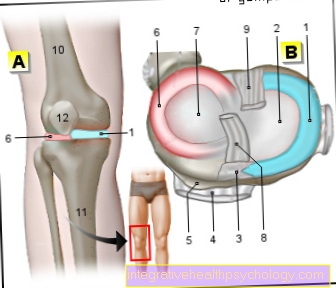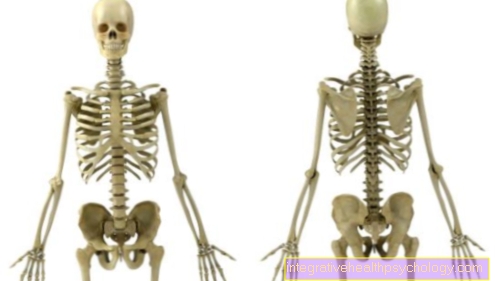Panner's disease
Synonyms
Osteochondrosis of the elbow joint
introduction
The disease known under the term Panner's disease is bone necrosis that occurs in the area of the elbow joint. In most cases, the affected patients are children and adolescents. Usually children between the ages of 6 and 10 are particularly affected. Bone necrosis known as Panner's disease is usually not observed in adulthood.

These symptoms are there
The clinical symptoms of Panner's disease are quite unspecific, especially at the beginning of the disease, and can be assigned to a number of joint and bone diseases. Most children with Panner's disease describe increasing pain as the disease progresses, which can be exacerbated by straining the elbow joint. In most cases, this pain is significantly reduced under rest conditions.
However, completely pain-free intervals are rare in Panner's disease without appropriate therapy. In addition, the pain can be provoked by direct pressure on the elbow. In addition, severe swelling can often be found in the affected elbow joints. In the course of the disease there is also a progressive stiffening of the joint. This stiffness can last for several months. Furthermore, the range of motion is also severely restricted at the beginning.
This manifests itself primarily in a restriction of the extension of the arm. Panner's disease is a chronic disease that can extend over a period of up to three years. In addition, some of the children affected report the repeated occurrence of clear rubbing and grinding noises in the area of the elbow joint. In the rarest of cases, structures of the elbow joint are trapped in Panner's disease.
What are the stages of Panner's disease?
Diagnostic imaging in Panner's disease is used to differentiate bone necrosis into four different stages, which occur one after the other.
- Stage I.
Sclerosis can be recognized in stage I. There are bone densities that are particularly pronounced below the cartilage of the elbow joint (subchondral sclerosis).
- Stage II
Stage II shows a loosening of the internal structures of the joint near the joint surface. It's the fragmentation stage.
- Stage III
Stage III is characterized by osteolysis. There is a destruction of bone tissue and thus a decrease in size of the epiphysis, the bone end of the humerus.
- Stage IV
In stage IV, the imaging shows how the epiphysis of the humerus regenerates due to the body's own repair processes.
Appointment with an elbow expert?

I would be happy to advise you!
Who am I?
My name is dr. Nicolas Gumpert. I am a specialist in orthopedics and the founder of .
Various television programs and print media report regularly about my work. On HR television you can see me every 6 weeks live on "Hallo Hessen".
As a former performance-oriented tennis player, I specialized early on in the conservative treatment of the elbow.
You can find me in:
- Lumedis - your orthopedic surgeon
Kaiserstrasse 14
60311 Frankfurt am Main
Directly to the online appointment arrangement
Unfortunately, it is currently only possible to make an appointment with private health insurers. I hope for your understanding!
Further information about myself can be found at Dr. Nicolas Gumpert
What are the underlying causes of Panner's disease?
The exact causes of Panner's disease have not yet been conclusively clarified. What is certain, however, is that a restricted blood flow to the bony parts of the elbow joint is decisive in the development of the disease. It is also assumed that the repeated occurrence of the smallest trauma (so-called Microtraumas) lead to this reduced blood flow during exercise and sporting activity.
In addition, non-traumatic circulatory disorders should also come into question as a possible cause. Since Panner's disease is noticeably common in some families, it can be assumed that there is a hereditary component.
The direct cause of this disease is a circulatory disorder of the growth plate in the area of the lower humerus or other bony structures of the elbow joint. Panner's disease can be diagnosed at different stages depending on the extent of the bone necrosis. This fact has a decisive influence on the possible treatment options as well as on the prognosis. In addition, it can be determined that children and adolescents who practice sports that put high stress on the elbow are more likely to develop Panner's disease. An empirical connection between these types of sport and bone necrosis of the elbow joint can therefore be assumed. To what extent the risk of illness actually increases due to heavy exposure has not yet been conclusively clarified.
How is Panner's disease treated?
As a rule, treatment of children with Panner's disease is primarily symptom-oriented. The aim is to alleviate the symptoms and, above all, the pain of the affected children. Various pain relievers (Analgesics) can be taken.
In addition, a temporary immobilization of the affected elbow joint and a sports leave (break) should be aimed for. Panner's disease usually heals completely within one to three years. Surgical therapy is only necessary in the rarest of cases for Panner's disease.
Diagnosis of Panner's disease
The diagnosis of Panner's disease takes place in several steps. A detailed doctor-patient discussion (anamnese) carried out. During this conversation, the parents and the affected child are questioned extensively about existing symptoms. In this context, the localization of the pain is of enormous importance. In addition, lifestyle habits and situations in which more complaints occur are decisive.
The attending physician then performs an extensive physical examination of the child. In addition to the elbow joint, the neighboring joints on the hand and shoulder are also the focus of this investigation. The doctor inspects the affected arm, paying particular attention to redness, swelling and deviations from the normal joint axis.
Furthermore, the attempt to trigger pressure pain in the area of the elbow joint can be effective in many cases. If the suspicion of Panner's disease is confirmed during the physical examination, an additional step should be to take x-rays. As a rule, the x-ray shows a clear brightening in the area of the humerus (capitulum humeri) that forms the joint, which indicates the presence of osteonecrosis.
A magnetic resonance tomogram (MRI of the elbow) can also be made for more precise diagnosis of Panner's disease. With the help of this MRI image of the elbow, both the involvement of the metaphysis of the bone and the course of the disease can be assessed.
In addition, important differential diagnoses (other possible diseases with similar symptoms due to the MRI) should be excluded in the course of Panner's disease diagnosis.
The most common differential diagnosis from Panner's disease is acute or chronic arthritis.
An extensive laboratory test is usually carried out to differentiate. Furthermore, the symptoms of Panner's disease can also suggest the presence of a disease called osteochondrosis dissecans. For this reason, older adolescents should also pay attention to demarking (de-marrowing) of a bone fragment on the joint surface.
In addition, the so-called avascular necrosis of the lower part of the upper arm applies (avascular necrosis of the trochlea humeri, the Hegemann's disease) as a common differential diagnosis to Panner's disease.
MRI of the elbow
In addition to x-rays, magnetic resonance tomography is a standard method for the diagnosis and follow-up of Panner's disease.
An MRI of the elbow is very well suited to determine the stage of bone necrosis and to treat it based on the classification. A beneficial advantage of MRI is that this diagnosis works without harmful radiation.
For more information on this topic, see: MRI of the elbow





























